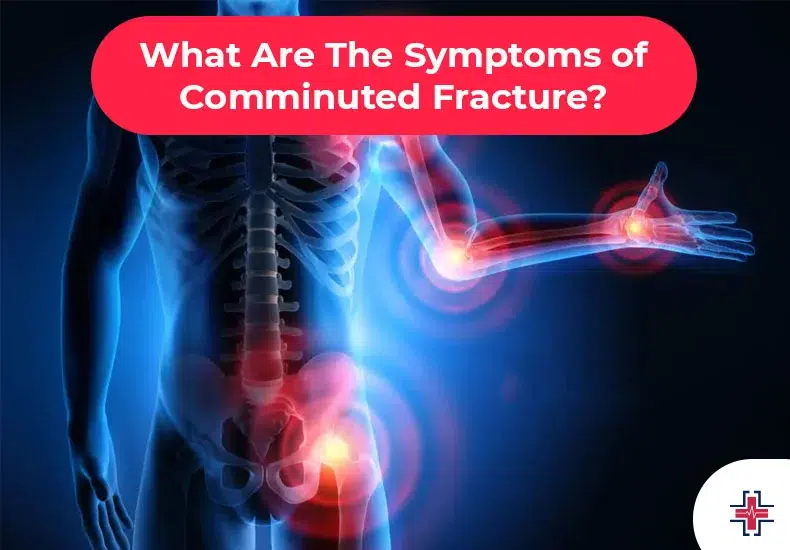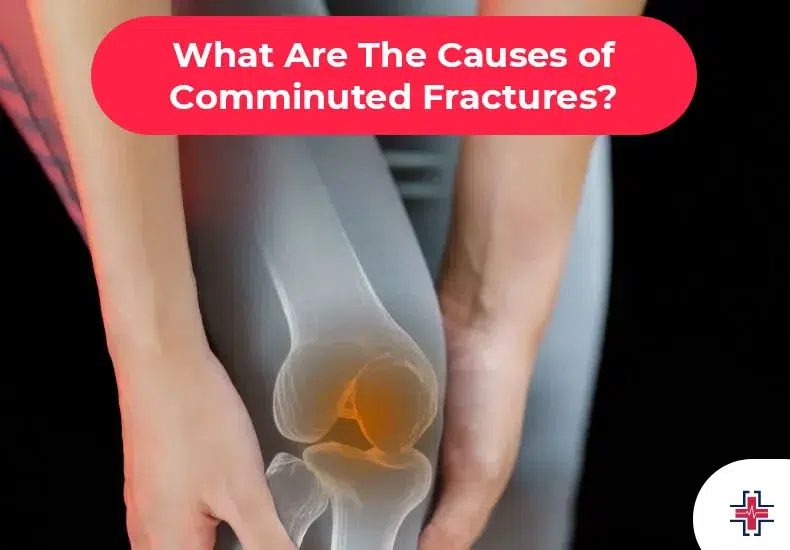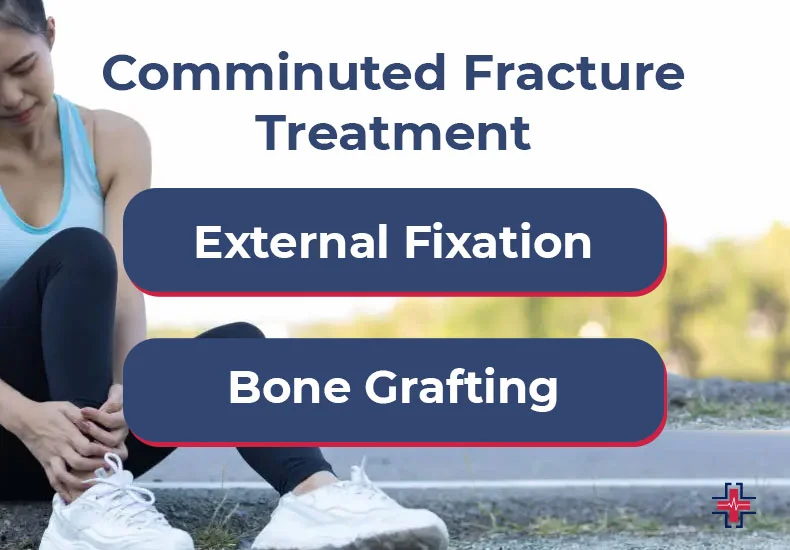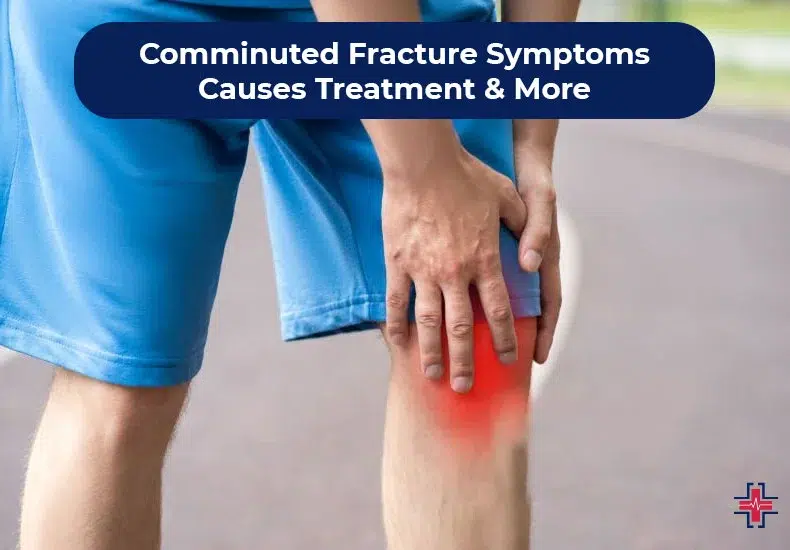A comminuted fracture is when a bone breaks into three or more pieces. These typically require surgery and take longer to heal than other fractures.
If a bone fractures into three or more fragments, it is called a comminuted fracture. To address associated problems and fix a comminuted fracture, surgery is frequently required. To join the bone fragments, medical professionals may employ fasteners like screws and rods. They remain in your bones indefinitely. Continue reading to learn more about the typical causes of comminuted fractures, warning signs to look out for, and medical professionals’ approaches to diagnosis and care.
What is a Comminuted Fracture?
Comminuted (pronounced “kah-meh-noot-ed”) fractures are a type of broken bone. The term comminuted fracture refers to a bone that is broken in at least two places. These fractures can affect any significant or long bone in your body. Some of the most common include
- Femur (thigh).
- Tibia (shin).
- Fibula (calf).
- Humerus (upper arm).
- Radius and ulna (forearm).
- Clavicle (collarbone).
- Skull.

Serious traumas like car accidents almost always cause comminuted fractures or falls from a high place. They are severe in large bones, and you will often need surgery to repair your bones. Sometimes, comminuted fractures happen to smaller bones and can heal without surgery. How long it takes to recover depends on which of your bones are fractured and what caused the breaks. Most people need up to a year to recover from a comminuted fracture if it involves one of the long or larger bones in your body, especially if it requires surgery.
Types of Comminuted Fractures
Comminuted fractures are bone fractures characterized by the splintering or fragmentation of the bone into multiple pieces. These fractures often result from high-energy trauma or significant force applied to the bone. Different types of comminuted fractures can occur in various parts of the body, each presenting unique challenges in terms of treatment and recovery. Let’s explore the details of specific comminuted fractures:

Comminuted Skull Fracture
Comminuted fractures of the skull involve severe head trauma, resulting in the fragmentation of the skull bones into multiple pieces. This type of fracture carries a heightened risk of brain injury, hemorrhage, and increased intracranial pressure.
Comminuted Distal Radius Fracture
A break in the radius bone near the wrist characterizes a comminuted distal radius fracture, typically caused by falls on outstretched hands or direct impact to the wrist. It leads to functional loss, deformity, and impaired hand movements.
Comminuted Fracture Patella
Comminuted fractures of the patella, or kneecap, occur due to direct trauma to the knee, often from a fall or impact. These fractures result in difficulties in walking, knee joint instability, and the potential for joint surface irregularities.
Comminuted Fracture Wrist
In the case of wrist fractures, multiple bone fragments are observed in the wrist area. Falls on outstretched hands or high-impact injuries are common causes, leading to loss of wrist function, chronic pain, and the risk of post-traumatic arthritis.
Comminuted Intertrochanteric Fracture
Comminuted fractures at the intertrochanteric region of the femur, typically seen in older adults, result from falls or osteoporosis. These fractures lead to difficulty in walking and leg shortening and often require surgical intervention.
Comminuted Bone Fracture
Comminuted bone fracture is a general term that refers to any bone fracture with multiple fragments. Comminuted bone fractures can result from various causes, including trauma, accidents, or pathological conditions. Complications may include impaired function, pain, and the risk of non-union.
Comminuted Displaced Fracture
Displaced comminuted fractures involve multiple bone fragments with significant misalignment. Commonly caused by traumatic injuries or high-impact accidents, they elevate the risk of joint dysfunction, deformity, and potential vascular or nerve damage.
Comminuted Nondisplaced Fracture
Nondisplaced comminuted fractures present multiple bone fragments without significant misalignment. While generally having a better prognosis than displaced fractures, they may still require treatment for proper healing.
Surgical intervention is often necessary to realign and stabilize the broken bone fragments in treating comminuted fractures. Rehabilitation and physical therapy play crucial roles in recovery, aiming to restore functionality and prevent long-term complications.
Who Gets Comminuted Fractures?
Like all bone fractures, comminuted fractures can happen to anyone. This is particularly valid given that they stem from severe experiences. Since nobody can foretell when or how they will be involved in an accident, everyone may suffer from a comminuted fracture.
What Are The Symptoms of Comminuted Fracture?
The symptoms of a comminuted fracture will be severe pain that increases with movement, swelling, bruising, deformity of a limb or body part, seeing the fractured bone through the skin, and inability or difficulty moving the affected body part or limb. As this type of fracture may have multiple, broken, jagged edges caused by the intense energy of the accident, fractured bones or bone fragments can often be forced through the skin, which is what we call an open or compound fracture. This complicates the situation by introducing an open wound into the fracture equation, increasing the chance for contamination and subsequent infection.

If you have a comminuted fracture, you’ll also likely experience severe symptoms of the trauma that caused it. Your symptoms will depend on the other injuries you have. But, in general, the symptoms of a comminuted fracture can include:
- Intense pain.
- Swelling around the site of the break
- Bruising on the skin above the break
- Tingling feeling or lack of sensation near the break
- The affected body part, such as an arm or leg, being at an unusual angle
- Not being able to move the affected body part without intense pain or stiffness
What Are The Causes of Comminuted Fractures?
Comminuted fractures stem from intense trauma, often due to high-impact incidents like car crashes or falls from considerable heights. These fractures involve the shattering of a bone into multiple fragments. Recognizing these causes is essential for prevention and developing effective treatment strategies to promote healing and recovery.

There are several causes of comminuted fractures that arise due to any trauma. These traumas include
- Car Accidents
- Fall from a height
- Fall from a ladder,
- Fall from a roof.
Any such trauma can affect bones and cause comminuted fractures. However, the bones that are affected by osteoporosis are more prone to comminuted fractures.
How to Diagnose Comminuted Fracture?
Your healthcare provider will diagnose a comminuted fracture with a physical exam and imaging tests. In some cases, this may be done in the emergency room if you’re admitted after trauma.

If you’re taken to an ER, a team of providers will work to stabilize you and treat your injuries in the order of severity, especially if some are life-threatening. After you’re stabilized, you will need imaging tests to confirm your fracture.
You’ll need at least one of a few imaging tests to take pictures of your fracture:
- X-rays: X-ray will confirm any comminuted or other fractures and show how damaged your bones are.
- Magnetic Resonance Imaging (MRI): Your provider might use an MRI to get a complete picture of the damage to your bones and the area around them. This will show them tissue around your bones, too. This is especially important to determine how trauma affected your muscles, connective tissue, and organs.
- CT scan: A CT scan will give your provider or surgeon a more detailed picture of your bones and the surrounding tissue than an X-ray.
Comminuted Fracture Treatment
If one of your long or large bones is broken, you’ll need surgery to repair a comminuted fracture. There are a few techniques used to repair comminuted fractures, and which one your surgeon uses will depend on your injuries, which bone is fractured, and any other complications after your trauma.

Your surgeon will realign (set) your bones to their correct position and then secure them in place so they can heal and grow together. They usually perform an internal fixation, which means your surgeon inserts pieces of metal into your bone to hold it in place while it heals. Internal fixation techniques include:
- Rods: A rod inserted through the center of your bone that runs from the bottom.
- Plates and screws: Metal plates screwed into your bone to hold them in place.
- Pins and wires: Pins and wires hold pieces of bone in place that are too small for other fasteners. They’ll typically be used at the same time as either rods or plates. You’ll probably need pins and wires to hold the pieces of your bone together after your comminuted fracture.
Some people live with these pieces inserted in them forever. You might need follow-up surgeries to remove them.
External Fixation
You might need an external fixation. This is often a temporary solution that stabilizes your fracture while your other injuries heal. Your surgeon will put screws on either side of the fracture inside your body and then connect them to a brace or bracket around the bone outside your body.
Bone Grafting
You might need bone grafting if your comminuted fracture is severely displaced or if your bone isn’t healing back together as well as it should. Your surgeon will insert additional bone tissue to rejoin your fractured bone. After that, they’ll usually perform an internal fixation to hold the pieces together while your bone regrows. Bone grafts can come from a few sources:
- Internally, from somewhere else in your body — usually the top of your hip bone.
- An external donor.
- It’s an artificial replacement piece.
On their own, comminuted fracture surgeries are outpatient procedures, which means you might be able to go home the same day. However, it’s likely the trauma that led to your comminuted fracture caused other injuries that will require you to stay in the hospital to recover.
After your surgery, the part of your body with the fractured bone in it will be immobilized. Depending on where this is, you’ll need some combination of a brace, splint, or cast before you can start putting any weight on it again or using it as you did before your injury.
Comminuted Fracture Healing Time
Compared to other types of fractured bones, comminuted fractures require more time to heal. They also have a far higher likelihood of involving problems.
The majority of comminuted fractures heal in a year or more. Your bone(s) will take a specific amount of time to recover, depending on how severe your fracture was and whether you experience complications.
Complications of Comminuted Fracture Treatment
Comminuted fractures involve the breakage of a bone into multiple fragments, and their treatment can be challenging. Complications associated with treating comminuted fractures may include:
- Delayed Healing: Comminuted fractures often take longer than more straightforward fractures. The presence of multiple bone fragments can impede the natural healing process.
- Nonunion: In some cases, the fractured bones may fail to heal completely, leading to nonunion. This can occur due to inadequate stabilization, poor blood supply, or other factors.
- Malunion: Improper alignment of fractured bone fragments during the healing process can result in malunion, where the bones heal in an anatomically correct position. This can lead to functional impairment and may require additional interventions.
- Infection: Open fractures or those treated with surgical intervention carry a risk of infection. The presence of multiple bone fragments and exposure to external elements can increase the likelihood of infection.
- Hardware Complications: If surgical intervention is required to stabilize the fracture, complications related to the implanted hardware may arise. These can include infection, hardware failure, or irritation of surrounding tissues.
- Joint Stiffness: Comminuted fractures involving joints may result in stiffness during the healing process. Physical therapy is often necessary to regain joint mobility and function.
- Nerve and Blood Vessel Damage: The presence of multiple bone fragments may increase the risk of damage to adjacent nerves and blood vessels. This can result in sensory or motor deficits and compromised blood circulation.
- Chronic Pain: Malunion, nonunion, or persistent joint stiffness may contribute to chronic pain in the affected area.
- Complex Rehabilitation: Rehabilitation for comminuted fractures can be more difficult and time-consuming. Patients may require prolonged physical therapy and rehabilitation periods to regain optimal function.
- Psychological Impact: Dealing with the challenges of a comminuted fracture, especially if it leads to long-term disability or impairment, can have psychological effects on the patient, including stress, anxiety, or depression.
Individuals with comminuted fractures need to receive prompt and appropriate medical care, follow their treatment plan diligently, and attend regular follow-ups to minimize the risk of complications and optimize the chances of a successful recovery.
Outlook For a Comminuted Fracture
Serious injuries can result from comminuted fractures. Your life could be permanently altered if you sustained additional injuries during the initial trauma. It might be difficult to distinguish between comminuted fractures and other traumas since they frequently result from incidents that pose a severe risk to life. Discuss your individualized treatment plan and what to anticipate from your trauma healer with your provider.
How Can I Reduce My Risk For Comminuted f=Fractures?
Follow these steps to reduce your risk of injury throughout your daily routine:
- Always wear your seatbelt.
- Wear the proper protective equipment for all activities and sports.
- Make sure your home and workspace are free from clutter that could trip you or others.
- Always use the proper tools or equipment at home to reach things. Never stand on chairs, tables, or countertops.
- Follow a diet and exercise plan that will help you maintain good bone health.
- Talk to your provider about a bone density test if you’re older than 50 or have a family history of osteoporosis.
Tips For Home Management of Comminuted Fractures
Here are some tips for managing the symptoms of your fracture at home:
- Don’t use or put weight on the area affected by the broken bones.
- Use over-the-counter pain medications, but don’t use ibuprofen or other nonsteroidal anti-inflammatory drugs (NSAIDs) that can increase your risk of internal bleeding.
- Use a cold compress to relieve pain near any areas that are swollen.
- Attend any physical therapy a doctor recommends to regain as much function from the affected area as possible.
FAQs
How soon after treatment will I feel better?
The improvement of your symptoms may take several weeks. You should be back to moving in a few weeks, depending on the kind of surgery you had to fix your comminuted fracture and which bones were shattered.
Intense discomfort that doesn’t go away should be reported to your healthcare professional.
How can I prevent a comminuted fracture?
Comminuted fractures are generally impossible to prevent since they occur unexpectedly entirely. Other than taking basic safety precautions, there is no way to avoid a comminuted fracture because you can never know when you will have a trauma. When using a cane or walker to assist with walking, you should always go with them and exercise extreme caution when walking on uneven surfaces.
What can I expect if I have a comminuted fracture?
Your recuperation period will be lengthier if you have a comminuted fracture than if you have another kind of broken bone. Healing could take up to a year, mainly if your initial trauma left you with further injuries.
Physical therapy is required to restore strength and range of motion in the injured body component. This therapy will be a component of your overall approach to recovering from other injuries.
Conclusion:
Serious injuries can result from comminuted fractures. It’s possible that you won’t be aware of one until after receiving treatment for the trauma that caused you harm. Even while learning you have a broken bone, especially a severe one, can be frightening, comminuted fractures typically respond well to therapy. At the ER of Mesquite, your healthcare professional will guide you on your recovery journey.
